Award of Excellence
A Green Sponge for a Water-Resilient City: Qunli Stormwater Park
Haerbin City, Heilongjiang Province, China
Turenscape and Peking University, Beijing
Client: Qunli New Town Government

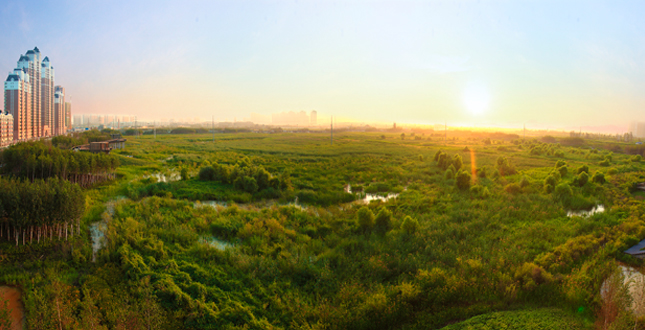 Close Me!
Close Me!Bird’s eye view of the storm water park (looking east, summer).
Download Hi-Res ImageImage: Kongjian Yu
Image 2 of 13
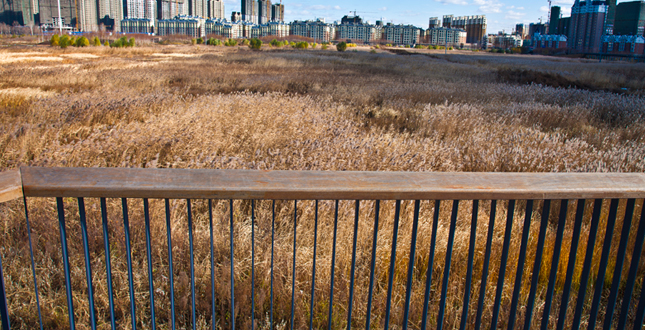 Close Me!
Close Me!Bird’s eye view of the storm water park (looking west, winter).
Download Hi-Res ImageImage: Kongjian Yu
Image 3 of 13
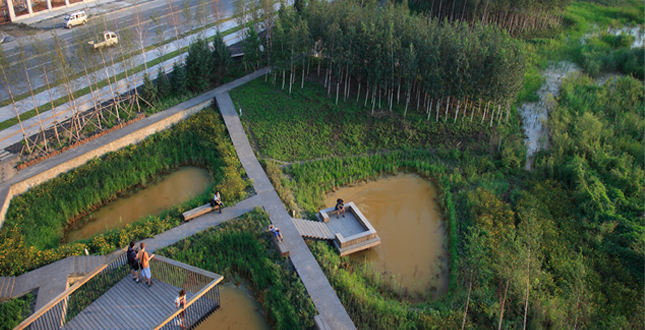 Close Me!
Close Me!Cut-and-fill to create an outer ring of mounds and ponds acting as a stormwater filtrating and cleansing buffer zone for the core wetland, and a transition between nature and city. View toward the south west.
Download Hi-Res ImageImage: Kongjian Yu
Image 4 of 13
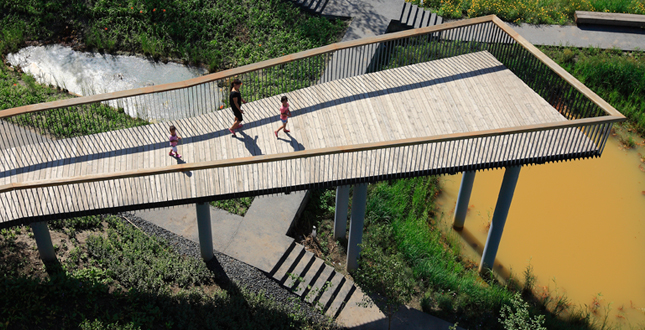 Close Me!
Close Me!Skywalk above the stormwater filtrating and cleansing ponds on the south eastern edge of the park created by excavations.
Download Hi-Res ImageImage: Kongjian Yu
Image 5 of 13
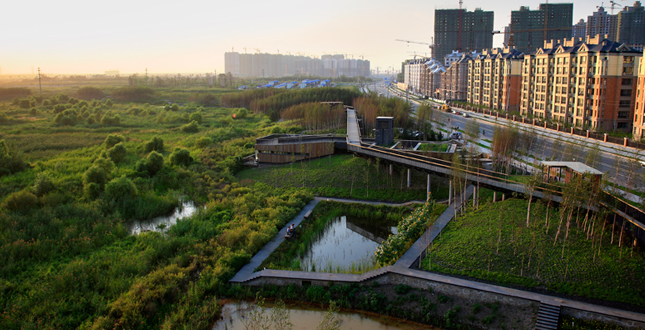 Close Me!
Close Me!The periphery of the park acts a border between city and nature. View toward the north east.
Download Hi-Res ImageImage: Kongjian Yu
Image 6 of 13
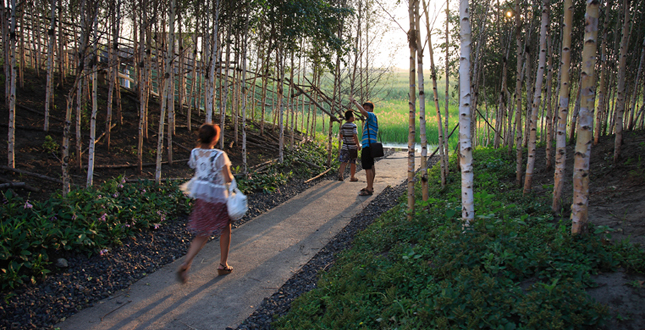 Close Me!
Close Me!The mounds with the dirt from the excavations on the park’s southern periphery create a valley experience and remind people of the regional natural landscape of rolling hills.
Download Hi-Res ImageImage: Kongjian Yu
Image 7 of 13
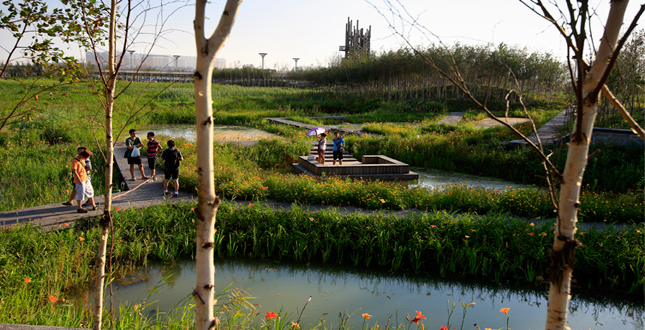 Close Me!
Close Me!A network of walkways is built into the ponds system allowing visitors to observe the wetland. Platforms and viewing towers lend panoramic views of the surroundings.
Download Hi-Res ImageImage: Kongjian Yu
Image 8 of 13
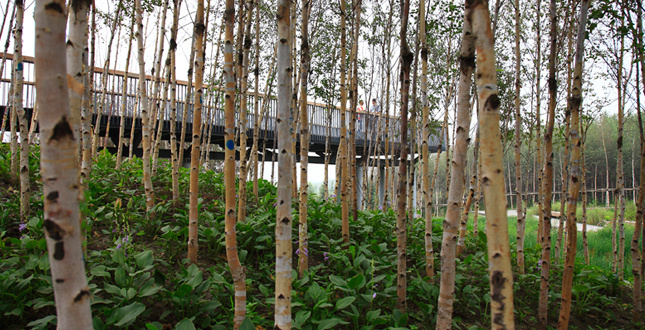 Close Me!
Close Me!In the east, the skywalk cuts through the silver birch forest on the mounds.
Download Hi-Res ImageImage: Kongjian Yu
Image 9 of 13
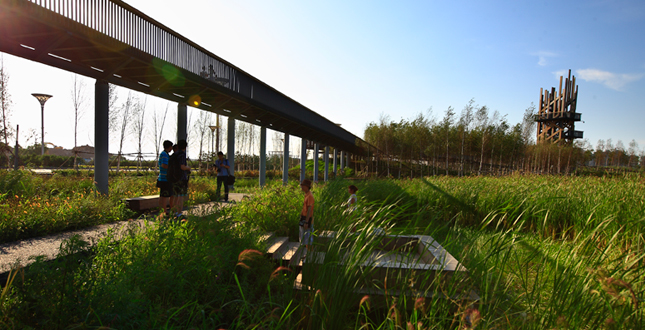 Close Me!
Close Me!The skywalk above the western filtrating ponds leading to a viewing tower.
Download Hi-Res ImageImage: Kongjian Yu
Image 10 of 13
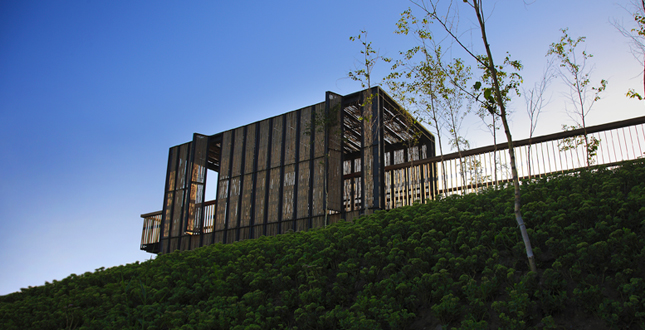 Close Me!
Close Me!One of the five evenly distributed pavilions along the perimeter (Bamboo, Wood, Brick, Stone, and Metal), the Bamboo Pavilion, sitting on the mound and above the wetland.
Download Hi-Res ImageImage: Kongjian Yu
Image 11 of 13
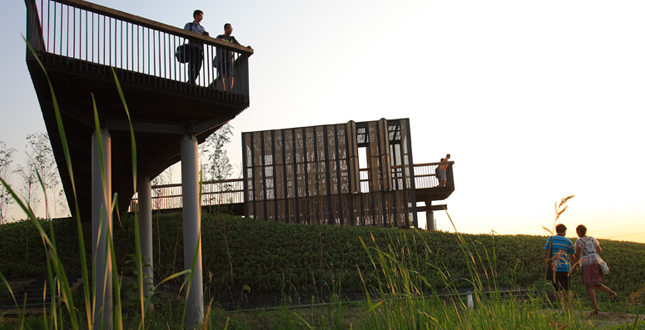 Close Me!
Close Me!The skywalk and the Bamboo Pavilion offer places to linger and enjoy views over the wetland.
Download Hi-Res ImageImage: Kongjian Yu
Image 12 of 13
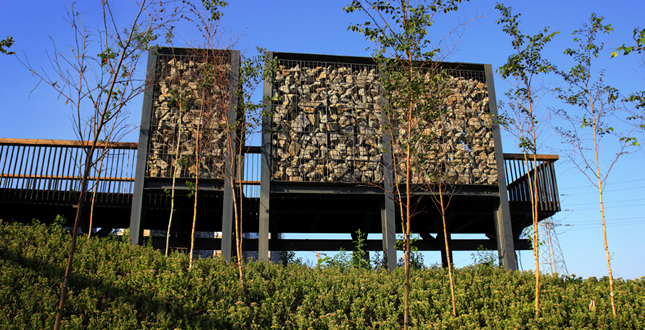 Close Me!
Close Me!The Stone Pavilion, using local stone to create a cool and unique resting and viewing place.
Download Hi-Res ImageImage: Kongjian Yu
Image 13 of 13
Project Statement
Contemporary cities are not resilient when faced with inundations of surface water. Landscape architecture can play a key role in addressing this problem. This project demonstrates a Stormwater park that acts as a green sponge, cleansing and storing urban stormwater and can be integrated with other ecosystem services including the protection of native habitats, aquifer recharge, recreational use, and aesthetic experience, in all these ways fostering urban development.
Project Narrative
—2012 Professional Awards Jury
Challenges and Objectives
Beginning in 2006, a 2,733 hectare (6,753 acres) new urban district, Qunli New Town, was planned for the eastern outskirts of Haerbin in northern China. Thirty-two million square meters (344,445,133 sq. ft.) of building floor area will be constructed in the next 13 to 15 years. More than one third of a million people are expected to live there. While about 16 percent of the developable land was zoned as permeable green space, the majority of the former flat plain will be covered with impermeable concrete. The annual rainfall there is 567 millimeters (22 inches), with the months of June, July, and August accounting for 60 to 70 percent of annual precipitation. Floods and waterlogging have occurred frequently in the past, while at the same time the ground water table continues to drop due to its overuse.
In mid-2009, the landscape architect was commissioned to design a park of 34 hectares (84 acres) right in the middle of this new town, which is listed as a protected regional wetland. The site is surrounded on four sides by roads and dense development. This wetland had thereby been severed from its water sources and was under threat. The original task given by the client was to preserve this wetland. Going beyond the original task of preserving the wetland, the landscape architect proposed to transform the area into an urban stormwater park that will provide multiple ecosystems services, and will collect, cleanse, and store stormwater and infiltrate it into the aquifer, protect and recover the native habitats, proved a public space for recreational use and aesthetics experience, as well as foster urban development.
The challenges are obvious: How can a disappearing wetland be preserved in the middle of the city when its ecological and biological processes have been cut off by the urban context? How such an urban wetland ecosystem can be designed to provide multiple ecosystems for the city? And what is the economic way to deal with such a big landscape?
Design Strategy
Several design strategies and elements were employed:
- The central part of the existing wetland is left along to allow the natural habitats to continue to evolve.
- Cut-and-fill strategy to create an outer ring of mounds and ponds. The cut-and-fill around the perimeter is a minimum earthwork strategy to transform the site. Earth is excavated and used to build up a necklace of ponds and mounds around the perimeter of the park. This ring acts as a stormwater filtrating and cleansing buffer zone for the core wetland, and a transition between nature and city. Stormwater from the newly built urban area is collected around the perimeter of the wetland and then released evenly into the wetland after having being filtered through the ponds. Native wetland grasses and meadows are grown on ponds of various depths, and natural processes are initiated. Groves of native silver Birch trees (Betula pendula) grow on mounds of various heights and create a dense woodland. A network of paths links the ring of ponds and mounds, allowing visitors to have a walking-through-forest experience. Platforms and seats are put near the ponds to enable people to have close contact with nature.
- The network of paths and platforms: A network of paths links the ring of ponds and mounds, allowing visitors to have a walking-through-forest experience. Platforms and seats are put near the ponds to enable people to have close contact with nature.
- A skywalk links the scattered mounds allowing residents to have an above-the-wetland and in-the-canopy experience. Platforms, five pavilions (Bamboo, Wood, Brick, Stone, and Metal), and two viewing towers (one made of steel and located at the east corner, the other one made of wood and looking like a tree at the north-west corner) are set on the mounds and connected by the skywalk, allowing visitors to have views into the distance and observation of nature in the center of the park.
Conclusion
The completely transformed site performs many functions, including collecting, cleansing, and storing stormwater, and recharging underground aquifers. The pre-existing wetland habitat has been restored and native biodiversity preserved. Potentially flooding stormwater now contributes to an environmental amenity in the city. The storm water park has not only become a popular urban amenity but has also been upgraded to a National Urban Wetland Park because of its improvement to ecological and biological conditions.
Project Resources
Design Team: Turenscape
Kongjian Yu, International ASLA; Long Xiang; Han Xiaoye; SongBenming; Li Hongli; Zhang Wenjuan; Men Fanxin; Meng Xiangyun; Li Guo; Zhang Li; Giuan Miaomiao; Xu Bo; Yuan enkai; He Chong; Chen Feng; and Lin Hong
Qunli New Town Government
Li Qin
Peking University Graduate School of Landscape Architecture






